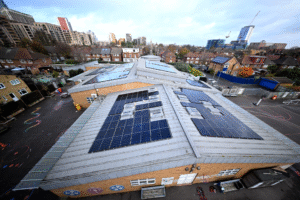The second annual 3Keel and Kingspan Global Retrofit Index shows that carbon reduction has now stalled in many European countries and is reversing in the US, with ageing built environments largely to blame.
Published Tuesday 14th November, the report has found that countries including France and Germany are no longer registering improvements in greenhouse gas output levels. Meanwhile, UK gains are beginning to plateau, while years of hard work are now unravelling in the United States as emissions from buildings is beginning to rise.
Based on the current trajectory, no G20 nation will be able to meet its net zero target year unless there are significant wins in the emissions reduction space. According to the researchers, the vast majority of buildings in the UK, France and Ireland remain category D or C for energy, while German households remain overly reliant on fossil fuels.
Retrofitting is urgently needed to facilitate the use of renewable energy alternatives, and bring existing buildings up to current efficiency standards. However, there are significant obstacles to this, including skills shortages, financial constraints, and a lack of public awareness. The Global Retrofit Index Interim Report, which can be found in full here, makes several recommendations on how to overcome these issues.
Five key elements needed to successfully roll out a national framework are also identified. These include setting net zero building performance standards, developing a national retrofit plan, providing financial incentives and support to ensure proposed work goes ahead, upskilling the workforce and up-scaling supply chains, and promoting best practice with data transparency.
Currently, the Netherlands has proven to be a world leader in retrofitting, with 36% less emissions from buildings in 2020 than 2010. Nevertheless, this still leaves 64% of greenhouse gases from the built environment, which now need to be tackled. At the other end of the table, the US has managed to cut just 3% of its building emissions, while the UK fares only slightly better at 6%. This compares with Germany (19% drop), Ireland (25% drop) and France (31% drop).
‘With over a quarter of total global emissions stemming from the operation of our buildings, retrofitting is a pivotal lever for decarbonising the global economy. However, this study shows a concerning stagnation of progress,’ said 3Keel’s Olwen Smith, author of the report.
‘Our analysis of six countries with old building stocks reveals that reductions in building emissions are now stalling and retrofitting rates are lagging far behind what is required to meet net-zero goals,’ he continued. ‘The tools and technologies required to improve energy performance in buildings already exist. Coordinated efforts between governments and the private sector are now needed to overcome implementation barriers and rapidly scale retrofitting to drive down building emissions globally.’
More on retrofitting:
https://environmentjournal.online/headlines/green-finance-institute-local-climate-bonds-toolkit/
https://environmentjournal.online/headlines/low-carbon-heating-cooling-ventilation-training-centre-reopens-in-birmingham/
https://environmentjournal.online/features-opinion/essexcc-economic-growth-energy-retrofit/
Image: Lute
















